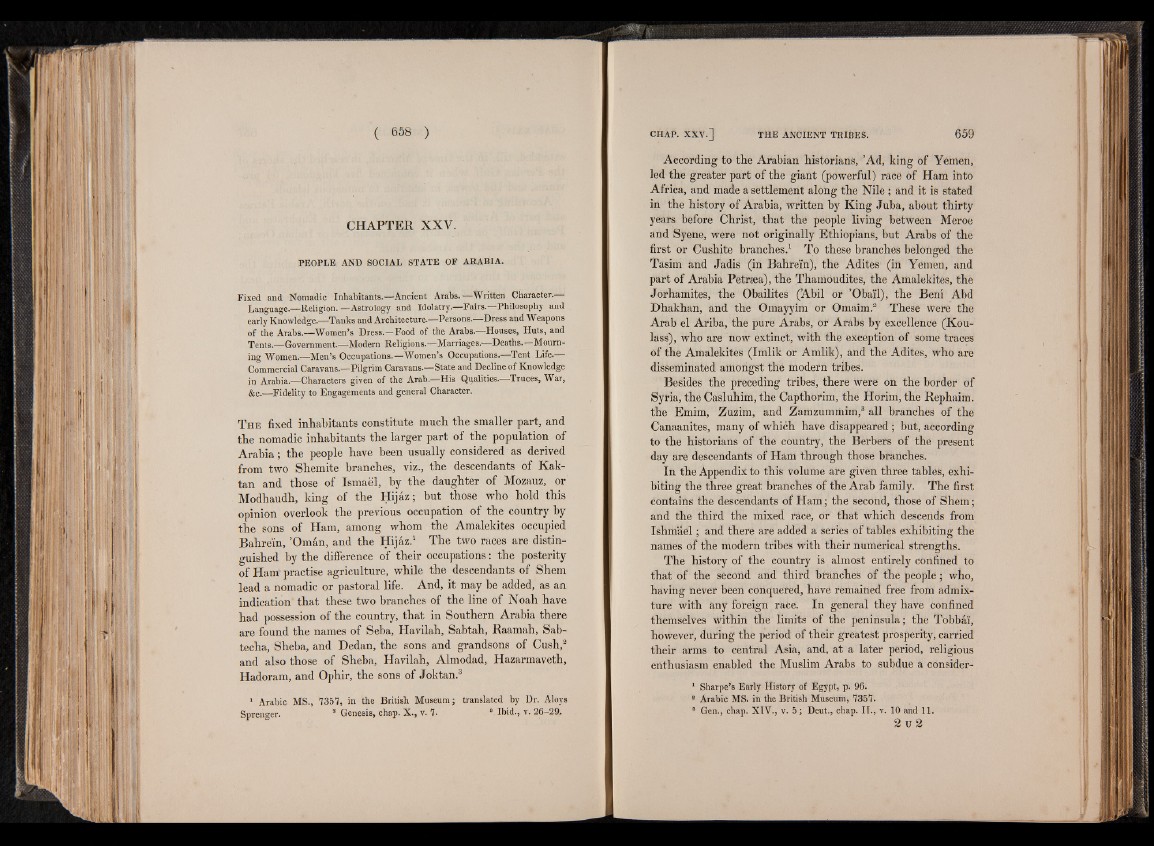
CHAPTER XXV.
PEOPLE AND SOCIAL STATE OF ARABIA.
Fixed and Nomadic Inhabitants.—Ancient Arabs.—Written Character.—
Language.—Religion.—Astrology and Idolatry.—Fairs.—Philosophy and
early Knowledge.—Tanks and Architecture.—Persons.— Dress and Weapons
of the Arabs.—Women’s Dress.—Food of the Arabs.—Houses, Huts, and
Ten;sg- Goveminent.—Modem Religions.—Marriages.' Deaths. Mourning
Women..—Men’s Occupations.—Women’s Occupations.—Tent Life.—
Commercial Caravans.—Pilgrim Caravans.—State and Decline of Knowledge
in Arabia.—Characters given of the Arab.-—His Qualities.—-Truces, War,
&c.—Fidelity to Engagements and general Character.
T h e fixed inhabitants constitute much the smaller part, and
the nomadic inhabitants the larger part of the population of
Arabia; the people have been usually considered as derived
from two Shemite branches, viz., the descendants of Kak-
tan and those of Ismael, by the daughter of Mozauz, or
Modhaudh, king of the Hijaz; but those who hold this
opinion overlook the previous occupation of the country by
the sons of Ham, among whom the Amalekites occupied
Bahrein, ’Oman, and the Hijaz.1 The two races are distinguished
by the difference of their occupations: the posterity
of Ham practise agriculture, while the descendants of Shem
lead a nomadic or pastoral life. And, it may be added, as an
indication that these two branches of the line of Noah have
had possession of the country, that in Southern Arabia there
are found the names of Seba, Havilah, Sabtah, Raamah, Sab-
techa, Sheba, and Dedan, the sons and grandsons of Cush,2
and also those of Sheba, Havilah, Almodad, Hazarmaveth,
Hadoram, and Ophir, the sons of Joktan.3
1 Arabic MS., 7357, in the British Museum; translated by Dr. Aloys
Sprenger. 8 Genesis, chap. X., v. 7- 8 Ibid., v. 26-29,
According to the Arabian historians, ’Ad, king of Yemen,
led the greater part of the giant (powerful) race of Ham into
Africa, and made a settlement along the Nile ; and it is stated
in the history of Arabia, Written by King Juba, about thirty
years before Christ, that the people living between Meroe
and Syene, were not originally Ethiopians, but Arabs of the
first or Cushite branches.1 To these branches belonged the
Tasim and Jadis (in Bahreïn), the Adites (in Yemen, and
part of Arabia Petræa), the Thamoudites, the Amalekites, the
Jorhamites, the Obailites (’Abil or ’Obaïl), the Beni Abd.
Dhakhan, and the Omayyim or Omaim.2 These were the
Arab el Ariba, the pure Arabs, or Arabs by excellence (Kou-
ldsS), who are how extinct, with the exception of some traces
of the Amalekites (Imlik or Amlik), and the Adites, who are
disseminated amongst thé modern tribes.
Besides the preceding tribes, there were on the border of
Syria, the Casluhim, the Capthorim, the Horim, the Rephaim.
the Emim, Zuzim, and Zamzumniim,3 all branches of the
Canaanites, many of which have disappeared ; but, according
to the historians of the country, the Berbers of the present
day are descendants of Ham through those branches.
In the Appendix to this volume are given three tables, exhibiting
the three great branches of the Arab family. The first
contains the descendants of Ham ; the second, those of Shem ;
and the third the mixed race, or that which descends from
Ishmael ; and there are added a series of tables exhibiting the
names of the modern tribes with their numerical strengths.
The history of the country is almost entirely confined to
that of the second and third branches of the people ; who,
having never been conquered, have remained free from admixture
with any foreign race. In general they have confined
themselves within the limits of the peninsula; the Tobbai,
however, during the period of their greatest prosperity, carried
their arms to central Asia, and, at a later period, religious
enthusiasm enabled the Muslim Arabs to subdue a consider-
1 Sharpe’s Early History of Egypt, p. 96.
8 Arabic MS. in the British Museum, 7357.
8 Gen., chap. XIV., v. 5 ; Deut., chap. II., v. 10 and 11.